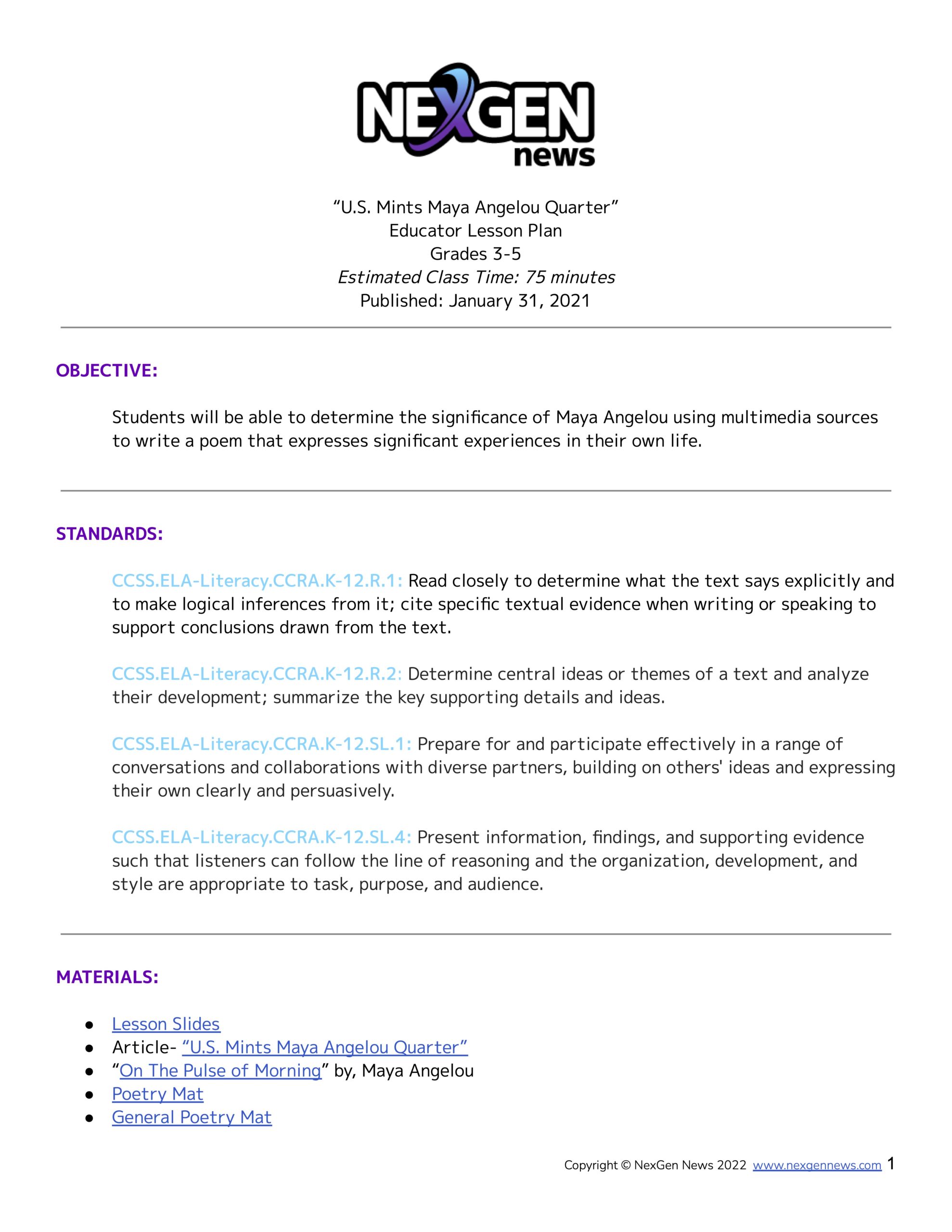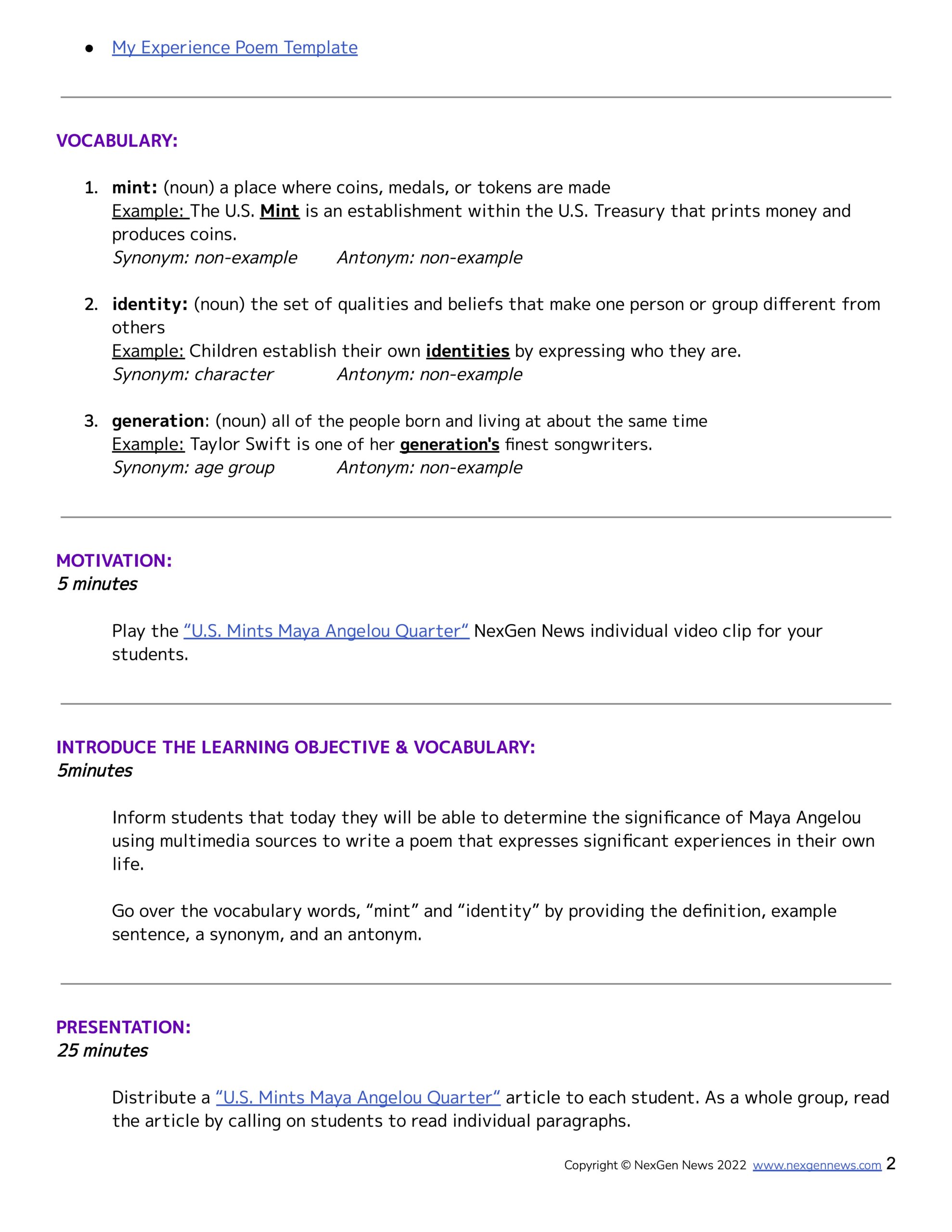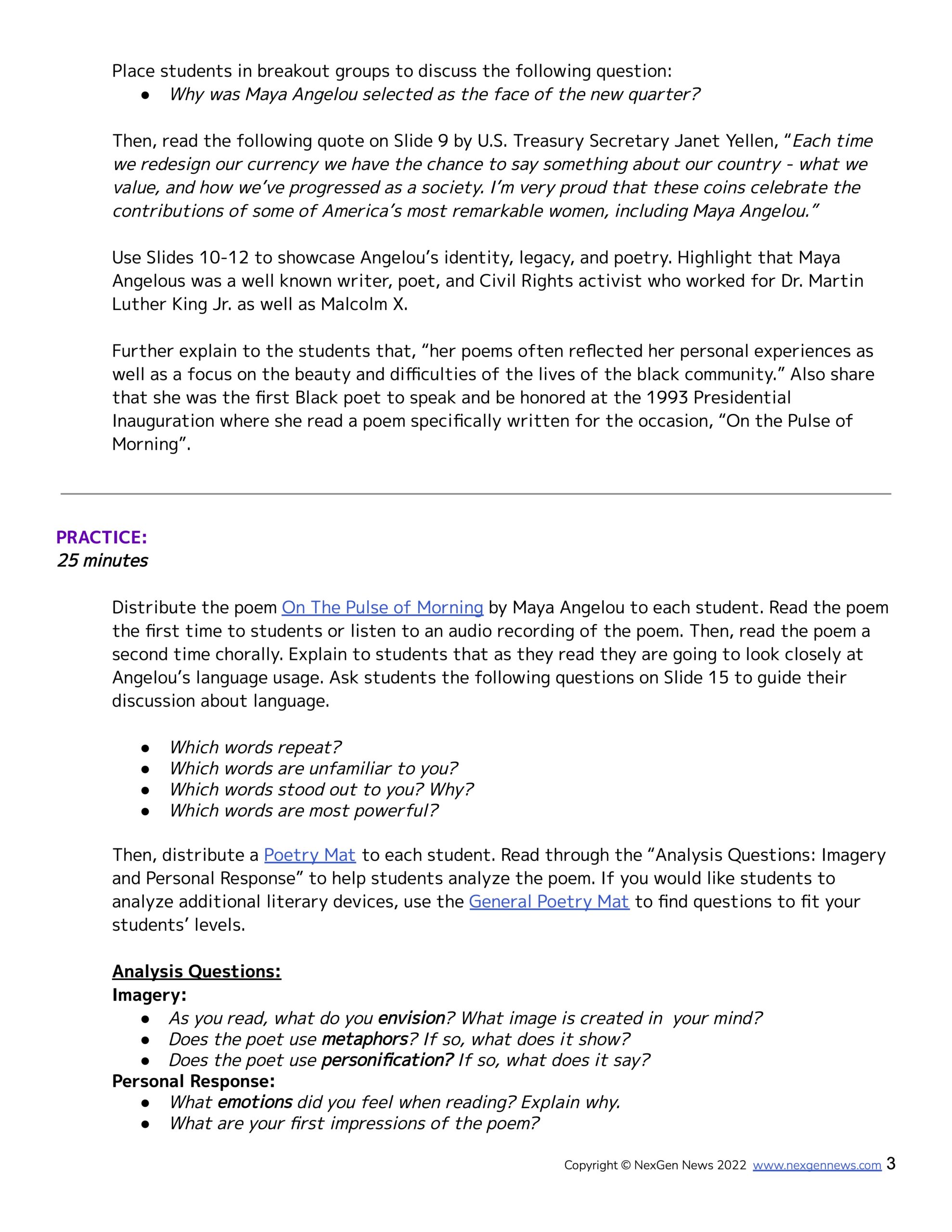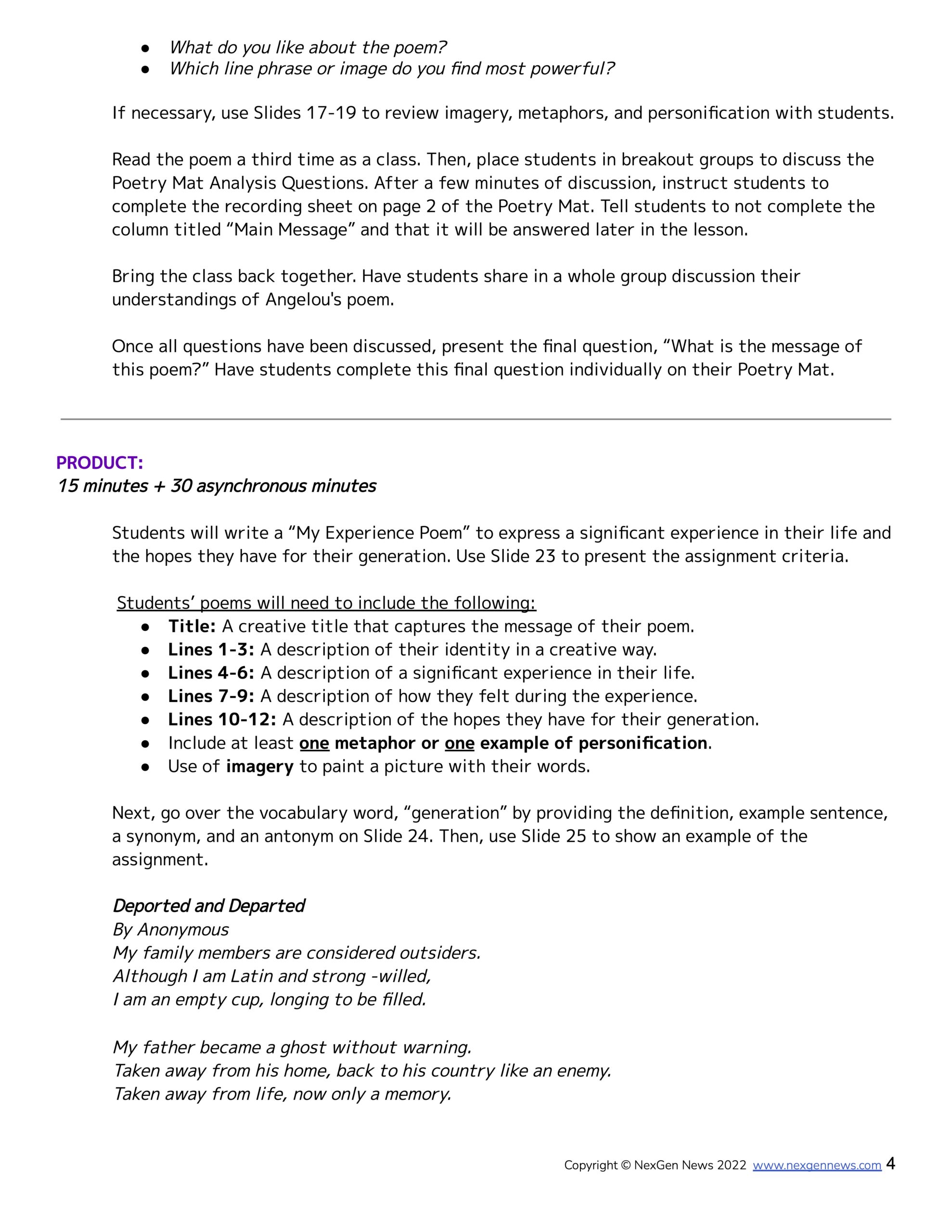U.S. Mints Maya Angelou Quarter
ENGAGE QUESTIONS
1. What did you learn about Maya Angelou and why do you think she’s featured on the U.S. quarter?
2. What other women should the American Women Quarters program feature? Explain why.
3. What characteristics do the historical figures featured on U.S. money have in common? Explain your answer. (George Washington, Thomas Jefferson, Abraham Lincoln, Alexander Hamilton, Andrew Jackson, Ulysses S. Grant, Benjamin Franklin , Franklin D. Roosevelt, and Sacagawea).
ACTIVITIES
WRITE: Pick your favorite Maya Angelou quote. Then, complete a Say, Mean, Matter Quote Analysis writing activity.
ART: Design your own U.S. coin or bill to feature a leader that you admire from history, or from your family, school, or community. Explain why you selected this leader below your drawing. You can draw your coin or bill on a separate sheet of paper or print this template.
TECHNOLOGY: Click here to listen to Maya Angelou’s story in a podcast format, watch her perform “On the Pulse of Morning” at Bill Clinton’s Inauguration, and read some of her most famous poems like “Caged Bird,” “Still I Rise,” or “Harlem Hopscotch.”
TEACH: Lesson Plan






TEACH: Lesson Slides
READING
U.S. Mints Maya Angelou Quarter
Written by Reuters, Adapted by NexGen News Staff
Starting in 2022, the U.S. Mint will showcase women of different experiences and backgrounds on the tails side of the quarter, including the late American poet, author, and activist Maya Angelou. The American Women Quarters Program will make as many as five designs each year highlighting women across fields like the sciences, space, civil rights, voting rights, and arts. Angelou will be the first Black woman in history seen on any U.S. coin.
The American Women Quarters Program
The U.S. Mint, or the government agency in charge of making coins, recently rolled out their plan to spotlight women like the late social activist and author Maya Angelou on the quarter. Angelou is the first Black woman to be seen on the quarter alongside first President George Washington, who has been featured on the coin since 1932 as part of the 200th anniversary of his birth. She will claim the coin’s tails side, while Washington will stay on the heads side of the quarter. The new coin is part of the American Women Quarters program, which features important women in American history.

A line drawing of the Maya Angelou quarter from the American Women series of quarters. Source: U.S. Mint/Public Domain
The program will run over four years, beginning in 2022 and ending in 2025. The U.S. Mint will create up to five designs on the tails side of the coin, with Washington taking up the heads side. The women honored will represent many different places, races, and backgrounds, from their involvement in voting rights and government to science, space, and the arts.
“Each time we redesign our currency, we have the chance to say something about our country – what we value, and how we’ve progressed as a society,” U.S. Treasury Secretary Janet Yellen said. Meaning, the U.S. Mint hopes to reflect the changing times on its coins.
Angelou is one of five celebrated American women to be seen on the coin in 2022, including: Dr. Sally Ride, the first American woman in space, Wilma Mankiller, the first female principal chief of the Cherokee nation, Nina Otero-Warren, an important figure in New Mexico’s voting movement and the first female superintendent of Santa Fe public schools, and Anna May Wong, the first Chinese American film star in Hollywood. Each woman was chosen after the public came up with possible nominees to the National Women’s History Museum website.
Maya Angelou: A Brief Biography
Maya Angelou was born in 1928 in St. Louis, Missouri. She grew up in the South and faced racism starting at a young age. Angelou was interested in writing early in her life, and especially liked poetry after memorizing the work of famous writers like Shakespeare and Edgar Allen Poe. In the 1950s, Angelou became active in the Civil Rights Movement and joined the Harlem Writers Guild in New York City, which helped publish the work of Black writers. In 1969, Angelou came out with “I Know Why the Caged Bird Sings,” an autobiography or story about her life to show her strength in the face of difficulties. The book spoke to many readers, helped others tell their own stories, and brought Angelou to the worldwide stage. Angelou published many other works, including poems, plays, screenplays, children’s books, and even cookbooks.
Having earned more than 30 honorary degrees from universities, Angelou read “On the Pulse of Morning” during former President Bill Clinton’s 1993 inauguration. An inauguration is the ceremony in which the president-elect begins their presidency and takes the oath of office. Angelou’s presentation made her the first Black woman to write and present a poem at a presidential inauguration. In 2010, Barack Obama honored Angelou by giving her the Presidential Medal of Freedom. In 2013, the National Book Foundation gave Maya Angelou its Literarian Award, an award given to authors for their outstanding role in the reading world.
Maya Angelou ultimately died in 2014 at the age of 86. Although she has passed, her work lives on, with poems like “Still I Rise” inspiring those who read her words today.
Maya Angelou’s Legacy
In addition to Angelou’s written legacy, she has paved the way for women to welcome and embrace who they are. At Angelou’s funeral in 2014, former First Lady Michelle Obama spoke warmly of her strength and inspiration: “She showed us that eventually if we stay true to who we are then the world would embrace us. And she did this not just for Black women but for all women, for all human beings.”
Angelou’s strength and impressive writing skills pushed others to rise, including Amanda Gorman, who considers Angelou to be a significant inspiration. Gorman is the youngest inaugural poet in U.S. history and author of “The Hill We Climb.” She read her spoken word poem at President Joe Biden’s inauguration in January 2021.
Although Maya Angelou may be gone physically, her spirit lives on through the inspiration she gives to women like Amanda Gorman. Now seen on the quarter, the U.S. Mint honors the legacy of women like Angelou and their visible impacts on society.
QUIZ & WRITING PROMPT
CCSS.ELA-Literacy.CCRA.R.2
A.) “Starting in 2022, the U.S. Mint will showcase women of different experiences and backgrounds on the tails side of the quarter, including the late American poet, author, and activist Maya Angelou.”
B.) “‘Each time we redesign our currency, we have the chance to say something about our country – what we value, and how we’ve progressed as a society,’ U.S. Treasury Secretary Janet Yellen said.”
C.) “In addition to Angelou’s written legacy, she has paved the way for women to welcome and embrace who they are.”
D.) “Although Maya Angelou may be gone physically, her spirit lives on through the inspiration she gives to women like Amanda Gorman.”
“The women honored will represent many different places, races, and backgrounds, from their involvement in voting rights and government to science, space, and the arts.”
CCSS.ELA-Literacy.CCRA.R.2
A.) “Washington will stay on the heads side of the quarter.”
B.) “Angelou is one of five celebrated American women to be seen on the coin in 2022, including: Dr. Sally Ride, the first American woman in space, Wilma Mankiller, the first female principal chief of the Cherokee nation, Nina Otero-Warren, an important figure in New Mexico’s voting movement and the first female superintendent of Santa Fe public schools, and Anna May Wong, the first Chinese American film star in Hollywood.”
C.) “The program will run over four years, beginning in 2022 and ending in 2025.”
D.) “Each woman was chosen after the public came up with possible nominees to the National Women’s History Museum website.”
CCSS.ELA-Literacy.CCRA.R.3
A.) Her written works helped others tell their own stories.
B.) Her written works led to experiences of racism at a young age.
C.) Her written works led to a Presidential Medal of Freedom.
D.) Her written works inspired others.
“In addition to Angelou’s written legacy, she has paved the way for women to welcome and embrace who they are.”
Which answer uses the word “pave” in the SAME way as the sentence above?
CCSS.ELA-Literacy.CCRA.R.4
A.) Some of the roads were paved over.
B.) The driveway is paved with concrete.
C.) The discovery paved the way for the development of effective new treatments.
D.) All this beautiful farmland will be paved over.

